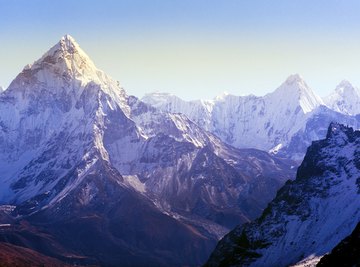
The Himalayas, a vast mountain range including the highest peaks in the world, stretch approximately 1,500 miles across portions of India, Pakistan, Nepal, Bhutan, Afghanistan and China. Like all mountain ranges, the backbone of the Himalayas is comprised of rock layers. The types of rocks found in the Himalayas vary widely depending on their specific location, but can be classified into three categories: metamorphic, igneous and sedimentary.
Geological Influences
In order to understand why certain rocks are found in the Himalayas, it helps to be familiar with the basics of the Himalaya’s geologic history. The Himalayas were produced by the motion of tectonic plates, which essentially brought India -- which was once an island -- crashing into Eurasia. This motion, which is still occurring today, is responsible for the uplifting of the different rock layers that constitute the structure of the Himalayas. Geologists recognize six distinct rock zones in the Himalayas, separated by fault zones. Some zones are composed primarily of one rock classification, while others feature a more diverse mixture.
Igneous Rocks
Igneous rocks form as a result of lava or magma cooling and solidifying. There are two main types of igneous rocks. Volcanic, or extrusive, igneous rocks form from lava that has been released above the Earth’s surface, while plutonic, or intrusive, igneous rocks form from magma underneath the ground. Two of the Himalayas’ major rock zones are comprised primarily of igneous plutonic rocks. Specific plutonic rock types in these zones include:
- granite
- diorite
- gabbro
- tonalite
- monazite
- pegmatite
Alunite is among the few extrusive igneous rocks found in the Himalayas.
Sedimentary Rocks
As their name implies, sedimentary rocks form when loose sediments on the Earth’s surface become compressed and bonded together. Many of the rocks found in the Himalayas are sedimentary, and actually once laid on an ocean floor millions of years ago when India was an island. Types of sedimentary rocks found in the Himalayas include:
- marl
- dolomite
- greywacke
- siltstone
- shale
- limestone
Within some of the Himalayas’ sedimentary rocks, fossils of ancient plants and animals can be found.
Metamorphic Rocks
Metamorphic rocks are rocks whose composition has been changed by heat, pressure or chemical processes. Metamorphic rocks present in the Himalayas include schist, migmatite, phyllite, gneiss and amphibolite. Additionally, metamorphosed forms of some sedimentary rocks occur in the region, such as quartzite, a metamorphosed type of sandstone; slate, a metamorphosed form of shale; and marble, a metamorphosed limestone. Some metamorphic rocks in the Himalayas have even been found to contain garnets.
About the Author
Based in western New York, Amy Harris began writing for Demand Media and Great Lakes Brewing News in 2010. Harris holds a Bachelor of Science in Mathematics from Penn State University; she taught high school math for several years and has also worked in the field of instructional design.
Photo Credits
TimHesterPhotography/iStock/Getty Images
